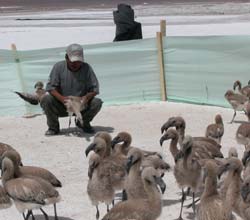The great flamingo round-up

Credit: Wildlife Conservation Society
Scientists corral, band and release over 300 threatened flamingoes for research
With South America’s Mars-like Altiplano region serving as a surreal back-drop, a group of scientists from the Bronx Zoo-based Wildlife Conservation Society (WCS) recently braved frigid temperatures, high winds, and altitudes of over 11,000 feet to fit bands on 300 threatened James’ flamingoes chicks. Working in Eduardo Avaroa Faunal Reserve in southern Bolivia, the banding effort is part of a multi-nation study on flamingo movements and population dynamics.
Collecting hundreds of birds at a time proved challenging for the scientists. They built a large funnel and a “flamingo corral” with wooden stakes and plastic sheeting, then rounded up a large group of chicks, which gather in flocks of several hundred birds called creches.
“Two groups set out, one on each side of the group of chicks, fanned out, then herded them into the funnel,” said Dr. Felicity Arengo, WCS assistant director of Latin America Programs. “There was some chaos and running around while we were herding the birds, but once they were in the pen they calmed down.”
After the chicks were rounded up, each was weighed, measured, and fitted with a plastic numbered tag that will allow scientists to identify individuals, before being released. Blood samples were taken from 70 of the largest chicks to record baseline data on their health.
For the past three years, WCS has participated in the banding project, fitting over 500 flamingoes with bands. Both James’ and Andean flamingoes are considered vulnerable with total populations estimated at 64,000 and 34,000 respectively. Since 1997, WCS has worked with local partners in flamingo research and conservation, because habitat is becoming more and more impacted by mining and other human activities.
The windswept Altiplano region that spans Bolivia, Peru, Chile and Argentina is recognized as one of the world’s most inhospitable regions, with extreme dry weather, blistering sunshine and caustic salt lakes dotting the landscape. For flamingoes however, the lakes are rich in microscopic food, while the surrounding wetlands make a perfect breeding ground.
“Most people think of flamingoes as delicate birds that live on tropical beaches and palm trees,” said Arengo. “In reality these are extremely tough animals adapted to some of the most rugged conditions on earth.”
ADDITIONAL CONTACT: Stephen Sautner-U.S. (718-220-3682;ssautner@wcs.org)
John Delaney-U.S. (718-220-3275; jdelaney@wcs.org)
Media Contact
More Information:
http://www.wcs.org/All latest news from the category: Ecology, The Environment and Conservation
This complex theme deals primarily with interactions between organisms and the environmental factors that impact them, but to a greater extent between individual inanimate environmental factors.
innovations-report offers informative reports and articles on topics such as climate protection, landscape conservation, ecological systems, wildlife and nature parks and ecosystem efficiency and balance.
Newest articles

Machine learning algorithm reveals long-theorized glass phase in crystal
Scientists have found evidence of an elusive, glassy phase of matter that emerges when a crystal’s perfect internal pattern is disrupted. X-ray technology and machine learning converge to shed light…

Mapping plant functional diversity from space
HKU ecologists revolutionize ecosystem monitoring with novel field-satellite integration. An international team of researchers, led by Professor Jin WU from the School of Biological Sciences at The University of Hong…

Inverters with constant full load capability
…enable an increase in the performance of electric drives. Overheating components significantly limit the performance of drivetrains in electric vehicles. Inverters in particular are subject to a high thermal load,…





















